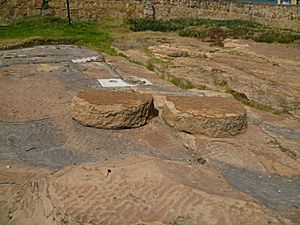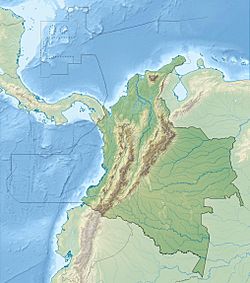Cojines del Zaque facts for kids

Cojines del Zaque in 2015
|
|
| Location | Tunja, Boyacá |
|---|---|
| Region | Altiplano Cundiboyacense, |
| Coordinates | 5°32′17.37″N 73°22′9.88″W / 5.5381583°N 73.3694111°W |
| Altitude | 2,834 m (9,298 ft) |
| Type | Ritual site |
| Part of | Historical Park Cojines del Zaque Muisca sites |
| Diameter | 1.1 metres (3.6 ft) |
| History | |
| Material | Sandstone |
| Abandoned | Spanish conquest |
| Periods | Late Muisca |
| Cultures | Muisca |
| Satellite of | Hunza |
| Site notes | |
| Public access | Yes |
The Cojines del Zaque (say: Koh-HEE-nes del SAH-keh) are an important ancient site. They are located in Tunja, Boyacá, Colombia. In ancient times, this city was called Hunza. The site belongs to the Muisca, an advanced civilization.
The "Cojines" are two large, round stones. The Muisca used these stones for their religious ceremonies. They worshipped their Sun god, Sué, and his wife, the Moon goddess, Chía. When Spanish explorers arrived, they called the stones Cojines del Diablo, meaning "Cushions of the Devil".
Contents
Who Were the Muisca People?
Before the Spanish conquest of the Muisca, the central highlands of the Colombian Andes were home to the Muisca. This area is known as the Altiplano Cundiboyacense. The Muisca were a well-organized civilization. They had their own unique religion and special rituals. Their main gods were the Sun god Sué and the Moon goddess Chía.
The Muisca lands were divided into different areas. Each area had its own ruler. The northern parts were led by the iraca of Sugamuxi. Another ruler was the tundama of Tundama. The most important ruler in Hunza (modern-day Tunja) was the zaque.
What Do the Cojines Look Like?
The Cojines are two circular stones. They are made from a type of rock called sandstone. You can find them at the bottom of San Lázaro hill in Tunja. The stone to the north is about 1.1 meters (3.6 feet) wide. The southern stone is about 1 meter (3.3 feet) wide.
The stones are placed in a special way. They are lined up with the path of the sun in the sky. Each stone has a sloped part on the west side. It also has a flat part on the east side. The zaque would kneel on these stones. He would pray to the Sun god Sué as the sun rose each morning.
People started studying the Cojines in 1847. In 1928, the city of Tunja made the stones an official archaeological site. This helps protect them for future generations.
Muisca Rituals and Celebrations
Every morning, the zaque would walk in a special parade. He would go from his large house, called a bohío, in Hunza to the Cojines. These daily walks were part of his prayers. The Muisca also held rituals at the Cojines del Zaque for planting and harvesting crops.
The Muisca calendar helped them know when to plant and harvest. These times usually happened in March and September. The Muisca wanted their farms to grow well. So, they held big celebrations for the gods at the Cojines del Zaque.
During these festivals, the Muisca danced together. They held hands and sang to the music of flutes and other instruments. Drums helped keep the rhythm for their dances. They also drank a special drink called chicha. Chicha is a traditional corn-based drink.
Sometimes, young boys, about twelve years old, were part of special ceremonies. These boys, called moxas, were from other groups. They were dedicated to the gods at the Cojines del Zaque.
See also
 In Spanish: Cojines del Zaque para niños
In Spanish: Cojines del Zaque para niños
- Sun Temple (Sogamoso)
- Muisca religion, mythology
- Piedras del Tunjo
- Pacanchique


